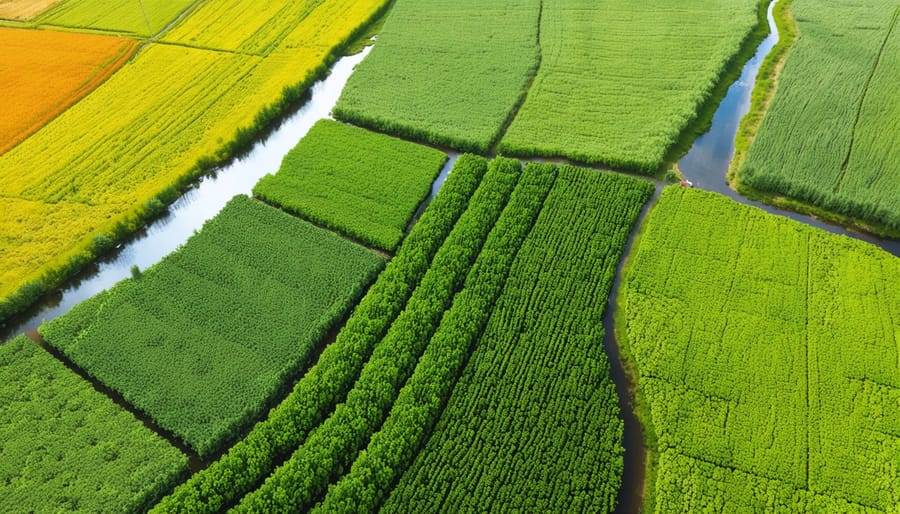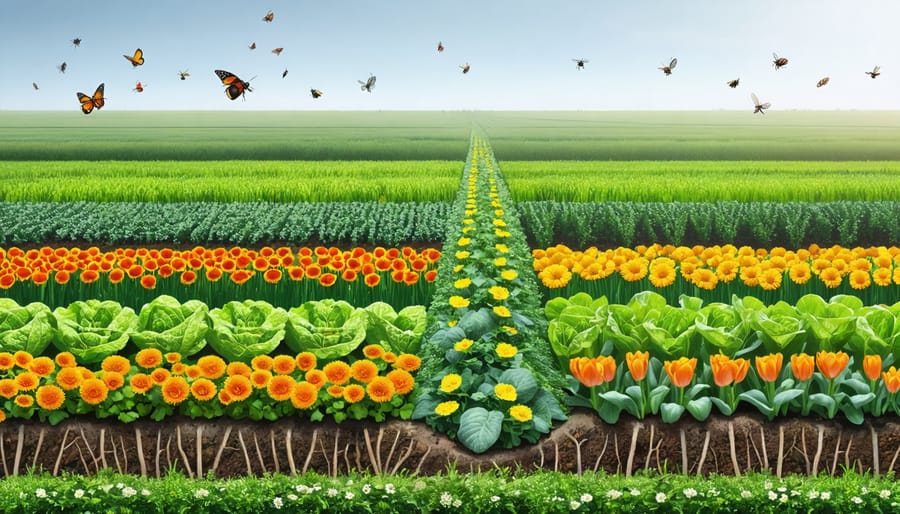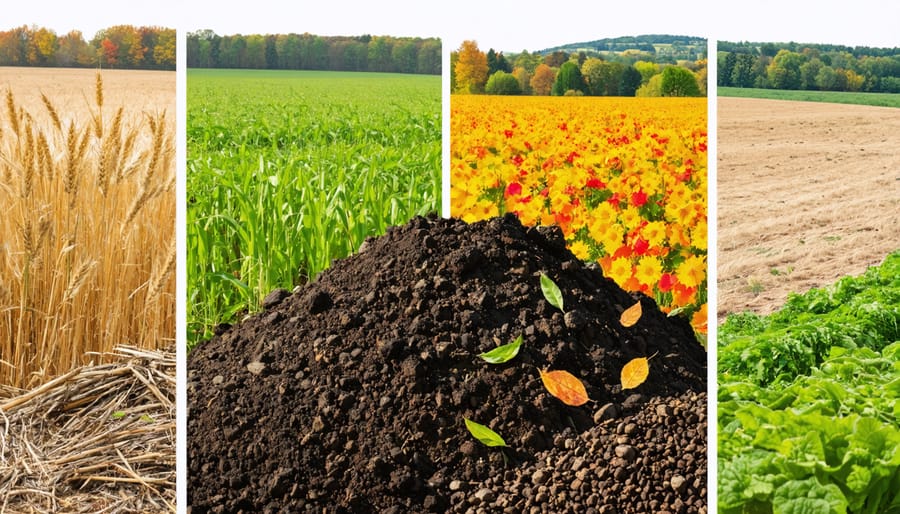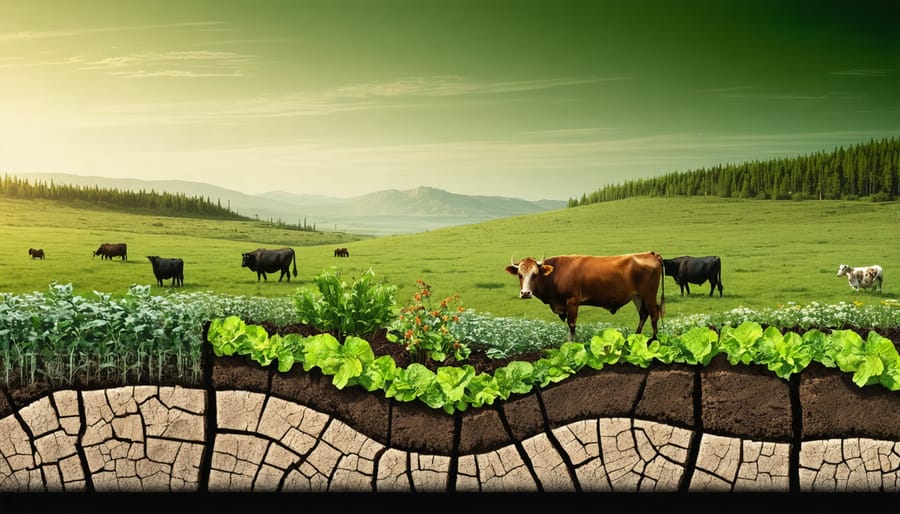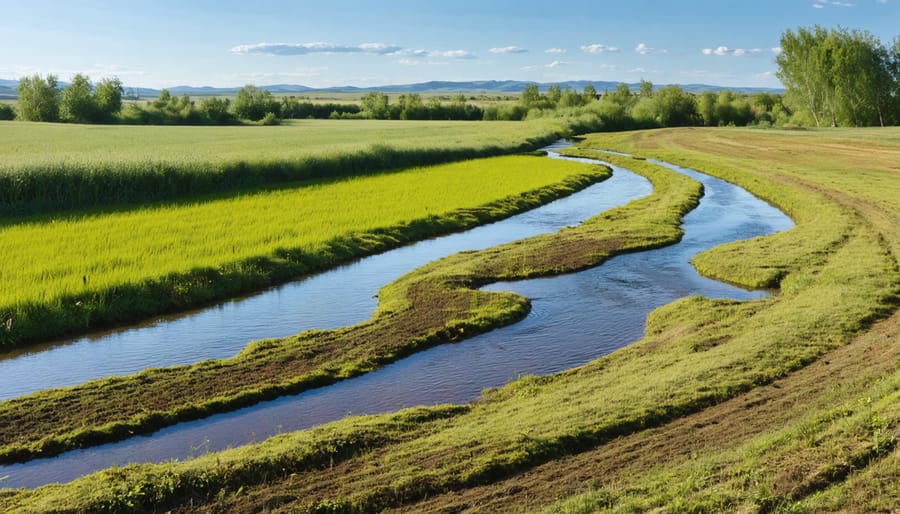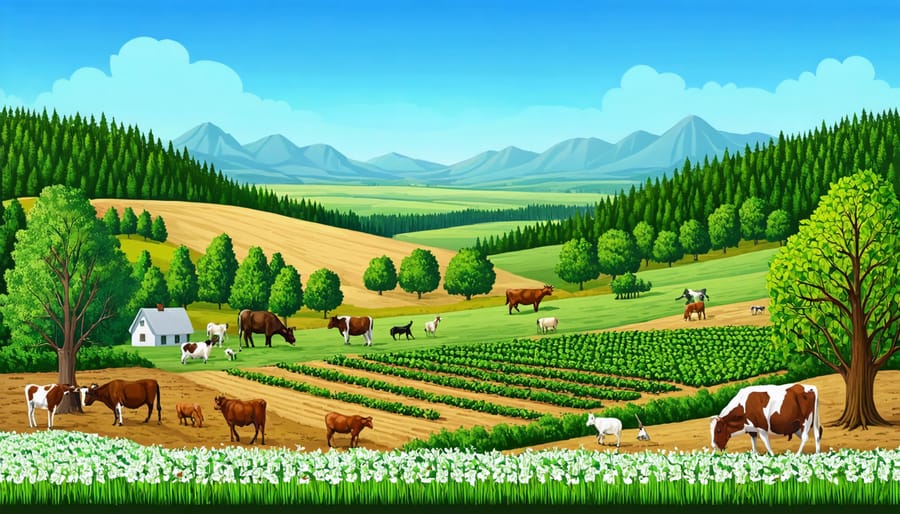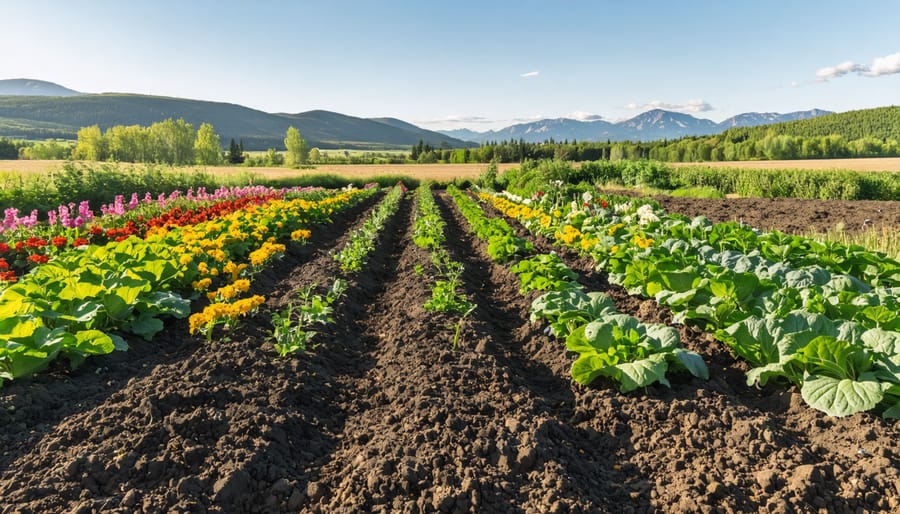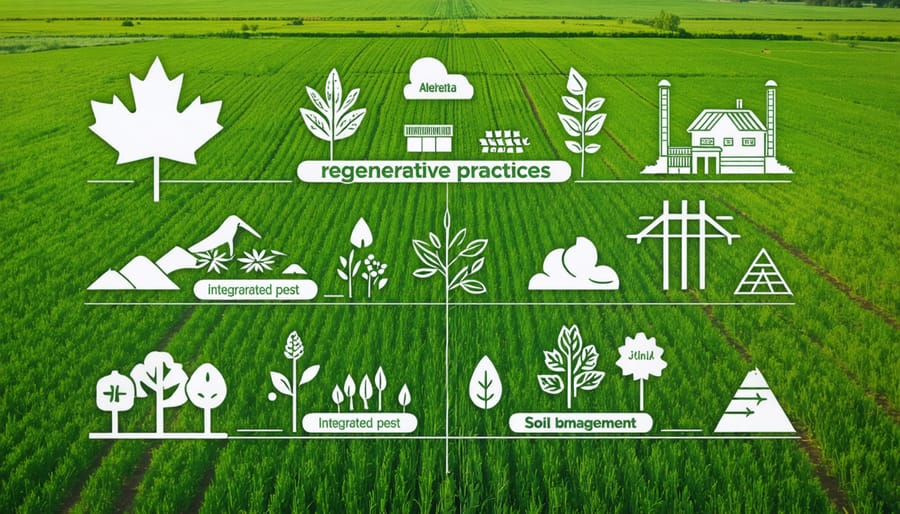Transform annual cropland into resilient food-producing systems by implementing perennial cropping strategies – a cornerstone of regenerative agriculture that’s revolutionizing Canadian farming. Plant deep-rooted perennials like kernza, sainfoin, and native grasses to build soil organic matter while reducing annual tillage operations by 75%. Integrate strategic combinations of fruit trees, berry bushes, and forage crops to create profitable multilayer systems that maximize both ecological benefits and market opportunities. Design field layouts that protect against Alberta’s challenging wind conditions while capturing moisture through strategic placement of windbreaks and companion plants. By transitioning just 20% of farmland to perennial systems, producers across the prairies are reporting 30% reductions in input costs while building climate resilience into their operations – all while maintaining steady income streams through diversified production channels.
Why Perennial Crops Matter for Alberta’s Future
Economic Benefits for Canadian Farmers
Perennial cropping offers significant financial advantages for Canadian farmers, particularly in reducing operational costs. By eliminating annual replanting, farmers can save an estimated $75-100 per hectare on seed costs and approximately $50-80 per hectare on fuel and equipment usage. Labor requirements typically decrease by 30-40% after the establishment year, freeing up time and resources for other farm activities.
The long-term economic benefits become especially apparent in years three through ten. Alberta farmers implementing perennial systems report input cost reductions of up to 60% compared to annual cropping, primarily through decreased fertilizer and pesticide requirements. Soil improvement over time leads to better water retention, reducing irrigation costs by roughly 25% in many cases.
These systems also provide income stability through diversification. Many perennial crops, such as alfalfa and sainfoin, offer multiple harvests per season and maintain their value even during challenging weather conditions. Additionally, carbon credit programs and ecosystem service payments are becoming available to farmers practicing perennial agriculture, creating new revenue streams.
When considering the complete financial picture, including reduced equipment wear and lower maintenance costs, perennial cropping systems typically show positive returns on investment within 2-3 years of establishment.
Environmental Impact on Prairie Ecosystems
Perennial cropping systems play a crucial role in enhancing prairie ecosystem health through multiple environmental benefits. These systems develop extensive root networks that significantly improve soil structure and organic matter content, creating resilient agricultural landscapes across Alberta’s diverse growing regions.
One of the most significant advantages is the impressive carbon sequestration benefits these systems provide. The deep, permanent root systems of perennial crops can store carbon at depths of up to 2 metres, making them powerful allies in climate change mitigation efforts.
These systems also support remarkable biodiversity improvements. Native pollinators, beneficial insects, and local bird species find shelter and food sources within perennial crop fields. Many Alberta farmers report increased wildlife activity and soil microorganism diversity after transitioning to perennial systems.
Additionally, these crops provide year-round soil coverage, reducing erosion and improving water retention. This protection is particularly valuable during Alberta’s intense summer storms and spring runoff periods, helping maintain topsoil and prevent nutrient loss while supporting overall ecosystem health.
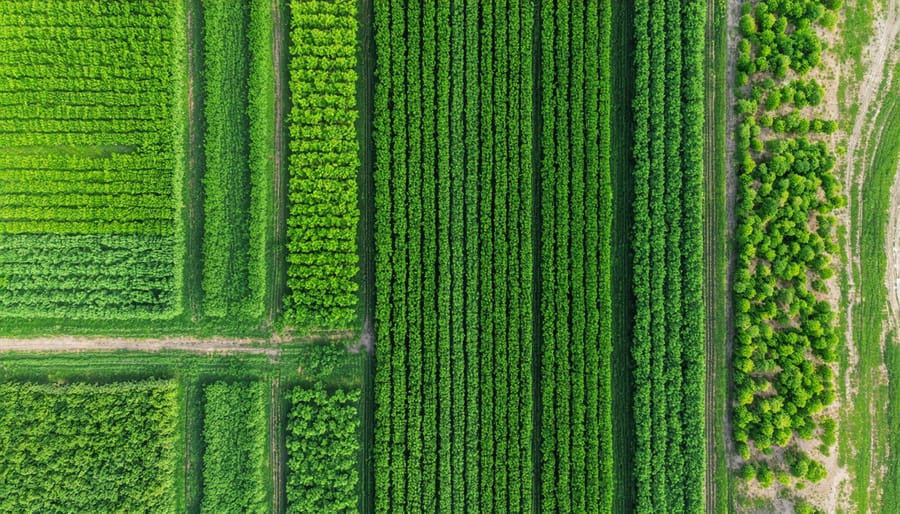
Popular Perennial Crops for Alberta’s Climate
Fruit and Nut Options
Alberta’s climate presents unique opportunities for hardy fruit and nut crops that can thrive in our challenging growing conditions. Farmers across the province are successfully establishing climate-resilient food forests with carefully selected varieties.
For fruit trees, hardy apple varieties like Goodland and Norkent have proven successful, consistently producing yields in zones 2b through 4a. Evans cherry trees, developed at the University of Alberta, demonstrate exceptional cold hardiness and reliable fruit production. Plum varieties such as Brook Red and Pembina also show excellent adaptability to our region.
When it comes to nuts, hazelnuts lead the way with hybrid varieties specifically bred for the Canadian prairies. The Saskatchewan-developed ‘Northern Blais’ hazelnut produces well-formed nuts and shows remarkable winter hardiness. Korean Pine offers another promising option, producing edible pine nuts while contributing to windbreak systems.
Many Alberta farmers have found success by incorporating these perennial crops into shelterbelts and hedgerows, maximizing land use while creating beneficial microclimates. These plantings not only provide marketable crops but also support beneficial insects and wildlife, contributing to overall farm biodiversity. For best results, producers should select varieties grafted onto cold-hardy rootstock and consider implementing wind protection strategies during establishment years.
Forage and Grain Alternatives
Alberta’s climate and soil conditions are well-suited for several perennial forage and grain options that can enhance farm sustainability while providing reliable yields. Winter-hardy grasses like intermediate wheatgrass and tall fescue have proven particularly successful, offering both grazing opportunities and potential grain harvests.
Kernza, a perennial wheat developed from intermediate wheatgrass, has gained attention among Alberta farmers for its deep root system and dual-purpose capabilities. While yields are typically lower than annual wheat, the reduced input costs and soil health benefits make it an attractive option for diversifying farm operations.
Native prairie grasses like blue grama and green needlegrass are making a comeback on Alberta farms, particularly in areas prone to drought. These species have naturally adapted to our climate over thousands of years and require minimal inputs while providing excellent forage quality.
For livestock producers, perennial alfalfa-grass mixtures remain a cornerstone of sustainable grazing systems. These combinations typically include species like meadow bromegrass or orchardgrass, which offer extended grazing seasons and improved soil structure.
Local seed producers are now developing region-specific varieties that better handle our unique growing conditions. Several Alberta farmers have successfully integrated these newer varieties into their rotation systems, reporting improved soil organic matter and reduced erosion on sloped fields. Early adopters suggest starting with small test plots to evaluate performance before scaling up to larger acreages.
Integration Strategies for Success
Planning Your Transition
Transitioning to perennial cropping requires careful planning and a phased approach to ensure success. Start by selecting a small test plot of 1-2 hectares to experiment with perennial integration while maintaining your existing operations. This allows you to learn and adjust without significant risk.
Begin with a comprehensive soil test to understand your land’s current health and needs. Many Alberta producers find fall soil testing provides the most accurate results for planning spring plantings. Consider consulting with local agricultural extension services or experienced perennial crop farmers in your area for guidance specific to your region.
Create a three-year transition plan that outlines:
– Year 1: Site preparation and initial perennial planting
– Year 2: Expansion and integration with existing annual crops
– Year 3: Full implementation and management refinement
When selecting perennial species, prioritize those well-adapted to Alberta’s climate. Popular options include alfalfa, sainfoin, and various native grasses. Consider market opportunities and potential partnerships with local buyers before making your final selection.
Document everything throughout your transition. Keep detailed records of planting dates, weather conditions, and crop responses. This information becomes invaluable as you scale up your perennial operation.
Remember that success often comes from starting small and growing gradually. Many successful Alberta farmers began with modest perennial plots and expanded based on their learning experiences. Join local farmer networks to share experiences and learn from others who have made similar transitions.
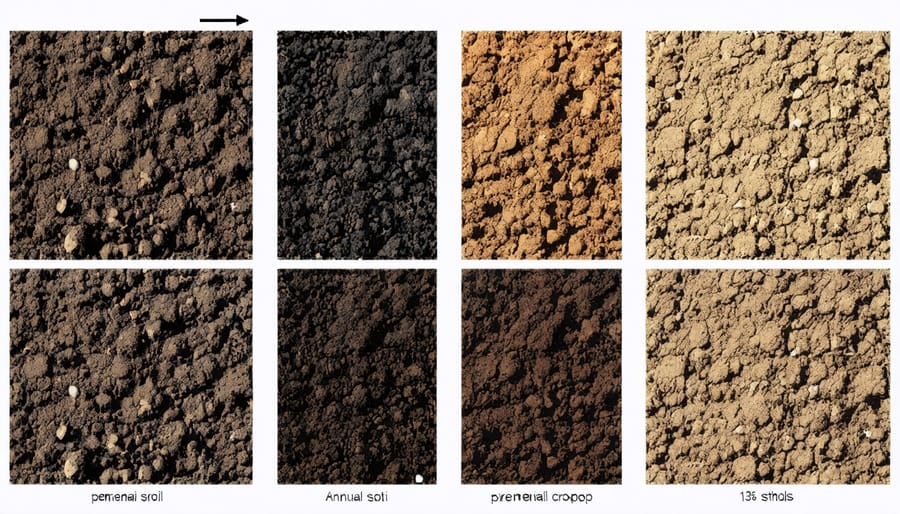
Soil Preparation and Management
Successful perennial cropping starts with proper soil health management, particularly in Alberta’s diverse soil conditions. Begin by conducting comprehensive soil tests to understand your baseline nutrients, pH levels, and organic matter content. Aim to maintain soil pH between 6.0 and 7.5 for optimal nutrient availability.
For Prairie soils, focus on building organic matter through cover cropping and minimal tillage. Incorporate composted manure at 10-15 tonnes per hectare during the establishment phase to improve soil structure and water retention. In clay-heavy soils common to central Alberta, add organic amendments to improve drainage and prevent compaction.
Maintain soil coverage year-round using living mulch or crop residue to protect against erosion and moisture loss. Consider implementing buffer strips between perennial crop rows to manage water flow and prevent soil degradation during spring thaw.
Monitor soil moisture levels regularly, especially during establishment years. Install soil moisture sensors at different depths to track water availability. Practice conservation tillage when necessary, but limit soil disturbance to preserve beneficial soil organisms and mycorrhizal networks.
Address nutrient needs through balanced fertilization programs, preferably using slow-release organic sources. Test soil annually and adjust amendments based on crop requirements and soil test results. Remember that healthy soil supports robust root systems, essential for perennial crop success in our climate.
Companion Planting Techniques
Strategic companion planting can significantly enhance the success of your perennial crops while promoting biodiversity and natural pest management. In Alberta’s diverse growing conditions, thoughtful plant combinations can create mutually beneficial relationships that improve soil health and crop yields.
Consider planting deep-rooted perennials like alfalfa alongside shallow-rooted crops to maximize soil resource utilization. Alfalfa’s nitrogen-fixing abilities benefit neighbouring plants while its extensive root system helps prevent soil erosion and improves soil structure.
Native prairie plants like yarrow and purple coneflower make excellent companions for fruit-bearing perennials. These plants attract beneficial insects that help with pollination and natural pest control. Many Alberta farmers have success pairing saskatoon berries with these native species, noting improved fruit production and reduced pest problems.
Herb integration is another effective strategy. Planting aromatics like sage, thyme, and mint near fruit trees can deter unwanted insects while providing additional harvests. However, remember to contain spreading herbs like mint in dedicated areas to prevent unwanted spread.
For windbreak protection, consider combining tall perennial grasses with shorter crops. This arrangement provides shelter for more delicate plants while maximizing space utilization. Local farmers report particular success with combining tall wheatgrass as windbreaks alongside berry bushes.
When planning companion plantings, factor in mature plant sizes and growth patterns to ensure adequate spacing and resource availability. Start small, observe what works in your specific conditions, and adjust your combinations based on results.
Real Success Stories from Alberta Farms
Meet Sarah and John Thompson from Lacombe County, who transformed their 300-hectare farm by incorporating perennial grains into their rotation system. “We started with a 40-hectare test plot of Kernza® in 2018,” Sarah explains. “After seeing the soil improvements and reduced input costs, we’ve expanded to 120 hectares of perennial crops.”
In Cardston County, Dave Miller’s success story centers around his innovative approach to combining cattle grazing with perennial wheat crops. “Our soil organic matter has increased by 2% over five years,” Dave notes. “Plus, we’re saving approximately $150 per hectare on annual seeding costs.”
The Henderson family farm near Camrose has been experimenting with perennial rye since 2019. “The first two years were about learning and adjusting,” says Mary Henderson. “Now we’re seeing consistent yields and have cut our spring fieldwork time by 40%.”
Perhaps one of the most inspiring examples comes from the Schmidt brothers in Red Deer County. Their 500-hectare operation integrates perennial forages with grain production. “We’ve reduced our fuel consumption by 30% and seen a significant increase in beneficial insects,” reports Tom Schmidt. “Our yields have stabilized, even during drought years.”
These success stories share common themes: initial careful planning, dedication through the establishment phase, and significant long-term benefits. Each farmer emphasizes the importance of starting small and scaling up based on results. They also highlight the value of connecting with other perennial crop farmers through local agricultural networks and extension services.
The Prairie Farm Rehabilitation Administration has documented these farms’ soil health improvements, showing organic matter increases ranging from 1.5% to 3% over five years. These real-world examples demonstrate that perennial cropping isn’t just theoretically beneficial – it’s practically achievable and economically viable in Alberta’s unique growing conditions.
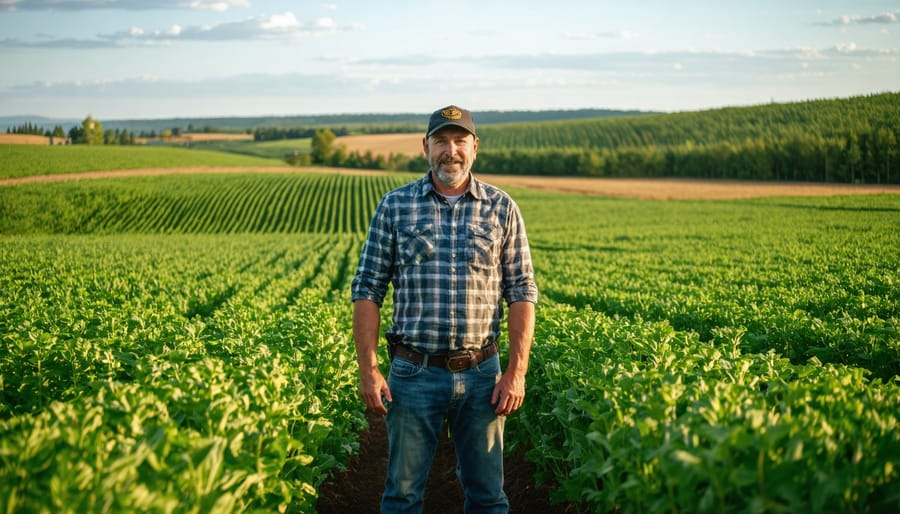
Transitioning to perennial cropping represents a significant but rewarding shift in agricultural practices for Canadian farmers. As we’ve explored throughout this article, the benefits of implementing perennial crops extend beyond soil health to include improved water retention, reduced erosion, and enhanced biodiversity on your farm.
For Alberta farmers considering this transition, start small by selecting a test plot of 1-2 hectares. Begin with hardy perennial varieties well-suited to our climate, such as intermediate wheatgrass or alfalfa. Connect with local agricultural extension offices and join farmer networks to share experiences and learn from others who have successfully implemented perennial systems.
Remember that success in perennial cropping requires patience and careful planning. The initial establishment period may take 2-3 years, but the long-term benefits to your soil and farm ecosystem make it worthwhile. Consider participating in government-supported programs that offer technical assistance and possible funding for sustainable agriculture initiatives.
Take advantage of resources available through Alberta Agriculture and Forestry, and don’t hesitate to reach out to experienced perennial crop farmers in your region. Many are willing to share their knowledge and provide guidance. Start your planning this winter, allowing time to prepare for spring planting and set your farm on a path toward greater resilience and sustainability.
Together, we can build a stronger, more sustainable agricultural future for Alberta, one perennial field at a time.

